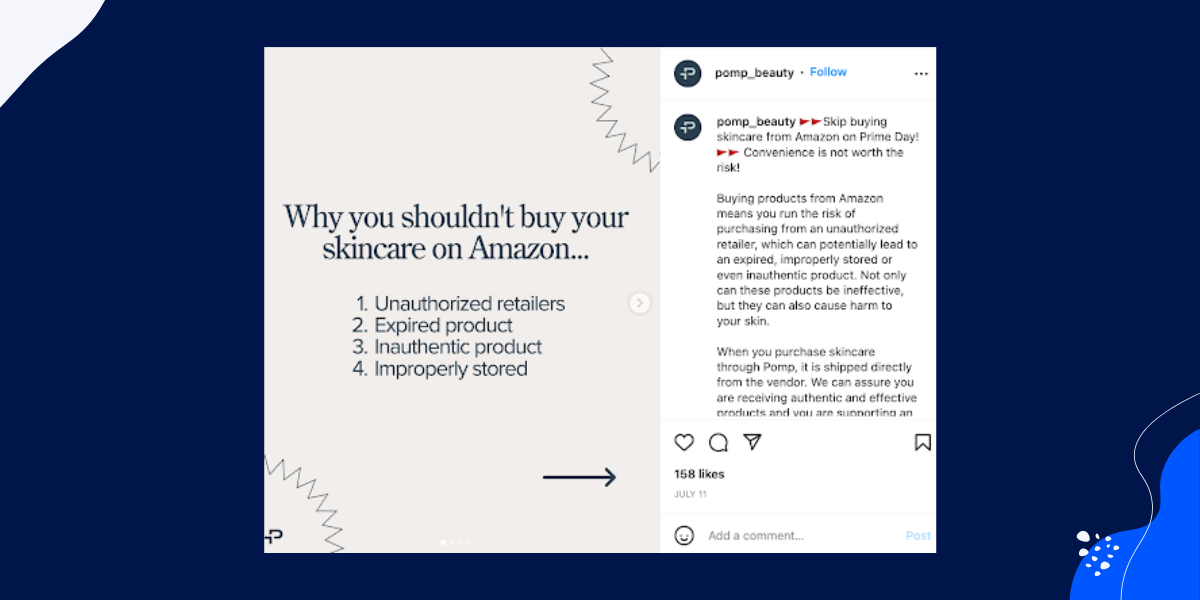.png)
.png)

Last updated on
February 26, 2024
The rise of eCommerce rise is not slowing down anytime soon, so businesses and consumers are always looking for something new and finding faster means of connections. While the traditional shops and retail stores model is always a ready-to-go option, there’s one more thing to try.
DTC or direct-to-consumer marketing.
It’s all about a powerful combination of your products and services with customer experience. And, of course, the strategies you use to appeal to the target audience.
Not so familiar with the term? No worries! We will cover everything about the main concept, strategies, and easy-to-follow examples to help you try this marketing alternative.
Direct-to-consumer (DTC) marketing encompasses how a brand communicates to its customers directly instead of through an intermediary retail establishment. For instance, DTC brands like “Warby Parker” will directly market their products to consumers, in contrast to retail brands like “Amazon” or “Walmart” that run promotions for different brands like Puma or Levi's.
Although DTC businesses have more control over their audience relationships, this implies that they are responsible for more sales workflow, including shipping and customer service, branding, and marketing.
This enables them to provide seamless, personalized experiences for customers along the marketing funnel.
Additionally, they gather marketing data throughout the customer experience to improve performance and support growth.
Digital marketing trends don't stay the same for very long, and the epidemic has forced many established B2C firms to adopt a DTC strategy.
Businesses that sell to consumers (B2C) must also market to consumers, although they frequently do it through partnering with online and offline retailers. In light of this, they don't need to draw clients to a physical location or personal website to make purchases. The retailer handles a significant portion of its marketing.
Take a look at the table below to understand the significant differences.
An intermediate service is part of the conventional retail client acquisition paradigm. Retailers then resell the products to consumers at retail prices after purchasing them from manufacturers at wholesale costs.
On the other hand, a DTC model entirely eliminates the retailer as the intermediary in this arrangement, allowing manufacturers to speak with customers directly.
Direct-to-consumer brands rely significantly on digital marketing methods and make excellent use of social media and eCommerce strategies, occasionally even fusing the two in practice known as social eCommerce.
Consider “Allbirds”, a clothing line popular among techies for its machine-washable wool sneakers, sustainable production, and adoption rate.
It has established its distribution channels and has complete control over its marketing initiatives by forging online communities of like-minded individuals and utilizing the influence of user-generated content.

You desire control over how your brand and goods are portrayed in the marketplace. Nobody else can compete with your value offer, branding, and messaging regarding marketing DTC items.
You can approach marketing any way you see fit as long as it generates the maximum revenue and provides a foundation of devoted customers.
Therefore, while conducting business directly with customers, you rely on your own eCommerce solutions rather than those provided by third parties, which results in lower profit margins and keeps you reliant on their business models.
Businesses develop relationships with customers by dealing with them directly, which may result in greater CLTVs and long-term profitability.
Building relationships is essential to developing customer loyalty to a business, whether the messaging takes place over the phone, through a chatbot, or by email marketing.
All those tasks are challenging to complete using a conventional marketing strategy, preventing companies from readily reaching their target customers. According to a study by Hubspot, 90% of consumers' response speed is high when it's to support questions.
Direct communication with customers can significantly improve customer relationships and brand loyalty.
DTC-based business models allow you to keep more significant profit margins. You can keep more money in your company by creating and selling your goods instead of paying suppliers.
For instance, the first is the conventional way to get in touch with a retailer, either an online or brick-and-mortar store and provide the product at wholesale price. The retailer will then sell the product at retail price, keeping the difference.
The second method uses the direct-to-consumer (DTC) strategy, in which you sell your goods directly to clients, typically through an online store, and keep all the net proceeds.
The latter approach is more economical, as you've undoubtedly already realized, enabling you to have a more considerable profit margin and even sell your goods for less money.
DTC means that businesses can interact with and inform their customers directly.
You may use the consumer data gathered to further improve a product or service by gathering insightful customer feedback.
Your company's ability to align its products with its audience's behaviors, demographics, and attributions will improve the more insights it has into its actions.
Achieving the desired conversion, and retention goals are significantly more straightforward when you have complete control over the customer journey.
You may streamline your plan and increase the profitability of your business by implementing the appropriate DTC marketing strategies and keeping up with current market developments.

DTC marketing techniques mainly rely on digital initiatives, particularly social media.
User-generated content (UGC) is online content produced by consumers or influential artists that brands utilize to promote themselves through digital channels and is one strategy that stands out. By empowering users to contribute their unique perspectives and experiences, brands can cultivate authenticity and deepen connections with their audience. Taking advantage of experienced UGC creators is also one smart way to do this.
For brands, collecting content from individuals is typically quicker and more scalable than producing their content, especially when each stage is automated with the aid of platforms like Mailmunch.
One of the main advantages of UGC is authenticity because it fosters brand loyalty and trust.
A significant factor in your company's success is brand recognition, which results from effective branding. Customers are considerably more likely to remain loyal to a brand when familiar with it.
Consequently, developing a solid brand identity is your first step. Typically, this includes
You may stand out from the crowd and develop a loyal customer base by developing a brand identity that is visually appealing and appeals to your target market.
Cohort-level UGC successfully increases engagement through debates, tests, surveys, and other activities. Community material may be efficiently acquired, creating a dedicated community section on social media platforms.
Additionally, you can set up a customized area on your website for successful DTC community contributions.
Such DTC strategies do more than entertain. With a straightforward approach, they even offer doors to more attractive marketing opportunities.
DTC advertising frequently includes influencer marketing. Brands collaborate with online creators to effectively increase exposure and sales.
The State of Influencer Marketing research claims that influencer marketing is more successful than other performance marketing initiatives on paid media, such as Facebook Ads, with gains of $5.78 for every $1 invested by firms. It makes sense that so many DTC businesses in various industries invest in it to expand their operations.
Several cosmetics brands increase their profits and retain customer loyalty through influencer marketing.
Nowadays, almost every firm invests in content marketing, or at least they should.
It includes a variety of content types, like social media posts and blogs, podcasts, and webinars, among many other opportunities, which can be pretty advantageous for any kind of business.
For instance, when created around a particular topic, blog content can bring massive organic traffic to your website. It is an ideal situation to convert a visitor into a paid customer. By regularly uploading blog posts, a website can manage to increase its organic monthly traffic.
Targeted traffic is a great way to increase the user base. Another hit idea is to use social media content. Brands can make a strong presence with thousands of followers and directly promote their products and services to the audience.
Who is your ideal client? Having this knowledge is crucial when developing a DTC marketing plan. After all, your plan will fail if you're developing marketing messaging for the incorrect targets.
Consider creating a customer survey to distribute to your email list, or maybe hiring a market research company to assist in creating buyer personas. This will tell you about your target market's marketing channels, purchasing habits, and attitudes toward your brand or sector.
Using this data will then give you knowledge on establishing your online presence, and what kind of messaging will appeal to them and persuade them to buy.
Increasing the variety of your marketing channels by partnering with other brands enables you to connect with as many people as possible. Yes, Facebook has more than two billion people that log on each month, but that doesn't mean you should stop there.
According to the "rule of seven" in marketing, the typical customer needs to hear a brand's message seven times before they decide to buy. You increase your chances of success by distributing content, advertising, and other marketing messaging over various channels and affiliations.
In addition, relying on one partnership (i.e., putting all of your eggs in one basket) can be a costly mistake. Keep trying to get new partners concerning occasions, holidays, new campaigns, etc.
In the DTC industry, personalizing offers is the secret to effective email marketing. You can create a highly tailored message that specifically addresses the requirements and problems of a given section by segmenting your audience. This can be a scalable, automated process using email marketing software like Mailmunch.
For instance, following a customer's subscription purchase, you can send them an email promoting related goods or services.
Firms have a variety of channels to choose from for DTC marketing, like affiliate marketing, SMS marketing, and whatnot. But referral marketing is the most beneficial of them all.
Why?
It's a strategy that compensates devoted clients with benefits in exchange for referring their contacts to a business. If you stop considering it, both parties benefit: businesses gain new clients while users receive a reward. Referrals frequently receive rewards as well.
For this reason, referral marketing is so popular among brands worldwide, especially those in the DTC sector.
Email marketing is a practical approach in DTC marketing. Sending emails to a segmented audience is one of the many ways to keep attention on your brand. With Mailmunch, DTC brands can create emails using custom-built email templates with an easy-to-use drag-and-drop builder.
Users can also duplicate the email template, change some aspects as they see fit according to the campaign, and automate the emails based on customertheir actions, ongoing promotions, etcand so on. As a brand with integrations, you can also check a list of integrations that Mailmunch supports.
Now’s the time to practically see the DTC marketing strategies. We found stunning and intriguing DTC marketing examples that can help you with more creative ideas.

This is a clear example of user-generated content (UGC). The influencer is rolling out the dice for the festive occasion by sharing hot chocolate and a Chestnut Praline Latte. It’s simple and catches the eye of the followers for the upcoming holiday season.

Nothing beats a good DTC campaign other than the cosmetic brands. In this example, TULA Skincare offers wellness with its skincare products like cleansers and sunscreen. Effective marketing is at its peak, as evident by the trendsetters on social media.

What's better than Netflix using the available shows as memes? Laugh all you want! This is a perfect example of how a streaming servicebrand can utilize social media to promote content for its target audience. They have the chance to localize the content, which is pretty evident due to the pun.

The self-proclaimed "most comfortable underwear in the world” Found the right voice for their business which was challenging when dealing with such a personal product. Still, MeUndies has nailed it with its encouraging and lighthearted tone. Their favorite channels for distribution are across social media platforms.

Another excellent example of DTC marketing comes from the upscale travel company Away. It is present on various social media platforms. Its Twitter account has relatable content about traveling and packing - a top-tier marketing strategy conveying the message and tone of the brand.

Talk about personalization with Pomp - a skincare brand. It can assist customers in finding the specific things they need by beginning their customer journey with a survey.
The company's marketing language also emphasizes skin care education for its clients because the entire business is based on individualized skin care advice.

Slack, a messaging and collaboration platform, is a symbol of clarity for all workspaces. Its brand voice is simple and clear and conveys the message to its audience in simple words. They target a global audience while keeping their content human and friendly so that any non-native user can understand it too.

The brand’s unique voice and message are loud and clear for all generations. The incorporated brand image is a powerful strategy that enables Coca-Cola to stand out from its competitors. Their brand voice is uplifting and evokes positivity. Also, their promotions are completely localized, allowing them to partner with other influencers.

Why not pick a soundtrack for your ride? This is one of the most fantastic co-branding partnerships between Uber and Spotify. Two different products with similar goals are drawing much attention. While a rider waits for an Uber ride, they can connect to Spotify.

Through an easy purchasing process, Warby Parker offers customers access to eyeglasses, sunglasses, blue-light spectacles, and other products at low costs. Warby Parker will seem a lot more approachable to people who may not have been able to purchase glasses the traditional way.

A famous DTC beauty brand that specializes in makeup has taken advantage of bloggers and other content creators in the most positive ways. They focus on hybrid formulations of skincare, accessories, and cosmetics. Take a look at a blog post by Christina Miller on her blog, The DayDreamer.
DTCs have more resources than most eCommerce firms. Therefore they can market more effectively.
To begin with, data must be gathered and used to tailor the consumer experience.
Additionally, convey your creativity and communicate your own and the client's stories authentically.
If you need help executing a unique DTC strategy, you can always go through our blog to learn more and how best to use it for your brand. Don’t be shy!
A voracious reader and a music lover, Ammar has been writing engaging and informative content for over 3 years for B2B and B2C markets. With a knack for writing SEO-optimized content, Ammar ensures the results speak for themselves.
Tags: